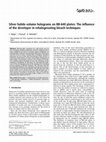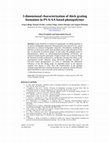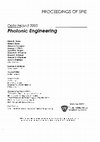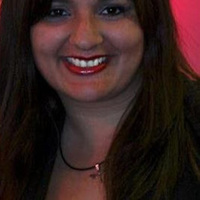Papers by Cristian Pascual
Journal of Modern Optics, 2001

Optik, 2001
Photographic emulsions are still widely used in the recording of phase holograms. Several techniq... more Photographic emulsions are still widely used in the recording of phase holograms. Several techniques have been optimized in order to produce phase holograms on photographic emulsions showing high diffraction efficiencies and low levels of noise. Among these techniques, bleached processes are one of the most interesting as they involve a relatively small number of steps and produce holograms of high quality. Of particular interest is the method of fixationfree rehalogenating bleaching because the shrinkage of the emulsion is minimum. In this paper we will study the influence of the development step in the fixation-free bleaching process applied to BB-640 emulsion. We will show that the development influences the optimum concentration of potassium bromide in the bleach solution. We will also show that good results can be obtained by using BB-640 plates for a wide variety of developers and that the values of the diffraction efficiency reached are rather high, as high as 87% for holograms developed in CW-C2.
Applied Optics, 2002
The mechanism of hologram formation in fixation-free rehalogenating bleaching processes have been... more The mechanism of hologram formation in fixation-free rehalogenating bleaching processes have been treated by different authors. The experiments carried out on Agfa 8E75 HD plates led to the conclusion that material transfer from the exposed to the unexposed zones is the main mechanism under the process. We present a simple model that explains the mechanism of hologram formation inside the emulsion. Also quantitative data obtained using both Agfa 8E75 HD and Slavich PFG-01 fine-grained red-sensitive emulsions are given and good agreement between theory and experiments are found.
Optics Express, 2002
The Coupled Wave Theory of Kogelnik has given a wellestablished basis for the comprehension of ho... more The Coupled Wave Theory of Kogelnik has given a wellestablished basis for the comprehension of how light propagates inside a hologram. This theory gives an accurate approximation for the diffraction efficiency of volume phase holograms and volume absorption holograms as well. Mixed holograms (phase and absorption) have been also treated from the point of view of this theory. For instance, Guibelalde theoretically described the diffraction efficiency of out of phase mixed volume gratings. In this work we will show that when using fixation-free rehalogenating bleaches, out of phase mixed volume gratings can be recorded on the hologram at high exposures. This is due to the oxidation products of the developer and the bleaching agent. The effects described theoretically for out of phase mixed volume hologram gratings are experimentally observed.
Journal of Modern Optics, 2000
Fixation-free rehalogenating bleaching is an interesting for the production of phase holograms. T... more Fixation-free rehalogenating bleaching is an interesting for the production of phase holograms. The shrinkage of the emulsion is reduced in comparison with other bleaching methods (reversal bleaching or rehalogenating bleaching with fixation). In this paper we present experimental results for fixation-free rehalogenating bleached holograms derived from the novel BB-640, a red-sensitive ultra-fine grain emulsion from Holographic Recording Technologies. The influence
Applied Optics, 2005
We have corrected typing errors related to the characterization of the dynamic range of the acryl... more We have corrected typing errors related to the characterization of the dynamic range of the acrylamide photopolymer described in an earlier study [Appl. Opt. 42, 7008 (2003)]. The M number is expressed as M͞# instead of M# as appears in the text. The value calculated from the experimental results that are included in the article is M͞# ϭ 3.8 instead of 38 as appears in the text.
Se presenta una técnica experimental para determinar el índice de refracción, el coeficiente de a... more Se presenta una técnica experimental para determinar el índice de refracción, el coeficiente de absorción y el espesor de materiales de registro holográfico. Los materiales están depositados como capas finas sobre una lámina planoparalela de vidrio. Se determina experimentalmente la reflectancia en función del ángulo de incidencia para luz polarizada linealmente paralela al plano de incidencia, de modo que los valores del índice de refracción, el coeficiente de absorción y el espesor se obtienen ajustando la ecuación de la reflectancia teórica a los datos experimentales. Como ejemplos se han analizado emulsiones fotográficas y fotopolímeros, obteniéndose un buen ajuste entre la función teórica y los datos experimentales.

Optics Express, 2006
Large thickness is required in holographic recording materials to be used as holographic memories... more Large thickness is required in holographic recording materials to be used as holographic memories. Photopolymers have proved to be a good alternative to construct holographic memories. Nevertheless, modeling the behavior of thick layers poses some problems due to high absorption of the dye, as discussed in previous papers. In this study, the gratings stored in photopolymers based on polyvinylalcohol/acrylamide (PVA/AA) are analyzed considering the attenuation of light in depth. This is done by fitting the theoretical results, predicted by a model that considers this effect, to the experimental results obtained using diffraction gratings recorded in PVA/AA based photopolymer. In order to determine the diffraction efficiency at the first Bragg angle, an algorithm based on the rigorous coupled wave theory is used. Also, the characteristics of the gratings obtained using different recording intensities are analyzed, and the effective optical thickness is seen to increase as the intensity is increased.
Journal of Physics D-applied Physics, 2002
The coupled wave theory of Kogelnik has given a well-established basis for the comprehension of h... more The coupled wave theory of Kogelnik has given a well-established basis for the comprehension of how light propagates inside a volume hologram. This theory gives a good approximation for the diffraction efficiency of both volume phase holograms and volume absorption holograms. Mixed holograms (phase and absorption) have also been dealt with from the point of view of the coupled wave

Different electromagnetic theories have been applied in order to understand the interaction of th... more Different electromagnetic theories have been applied in order to understand the interaction of the electromagnetic radiation with diffraction gratings. Kogelnik's Coupled Wave Theory, for instance, has been applied with success to describe the diffraction properties of sinusoidal volume gratings. Nonetheless the predictions of Kogelnik's theory deviate from the actual behaviour whenever the hologram is thin or the refractive index is high. In these cases, it is necessary to use a more general Coupled Wave Theory (CW) or the Rigorous Coupled Wave Theory (RCW). Both of these theories allow for more than two orders propagating inside the hologram. On the other hand, there are some methods that have been used long in different physical situations, but with relatively low application in the field of holography. This is the case of the finite difference in the temporal domain (FDTD) method to solve Maxwell equations. In this work we present an implementation of this method applied to volume holographic diffraction gratings.
Physics Letters A, 2007
Las primeras 3 la 1 la respuesta es estalin 2 es troski la 3 es Lenin .









Uploads
Papers by Cristian Pascual